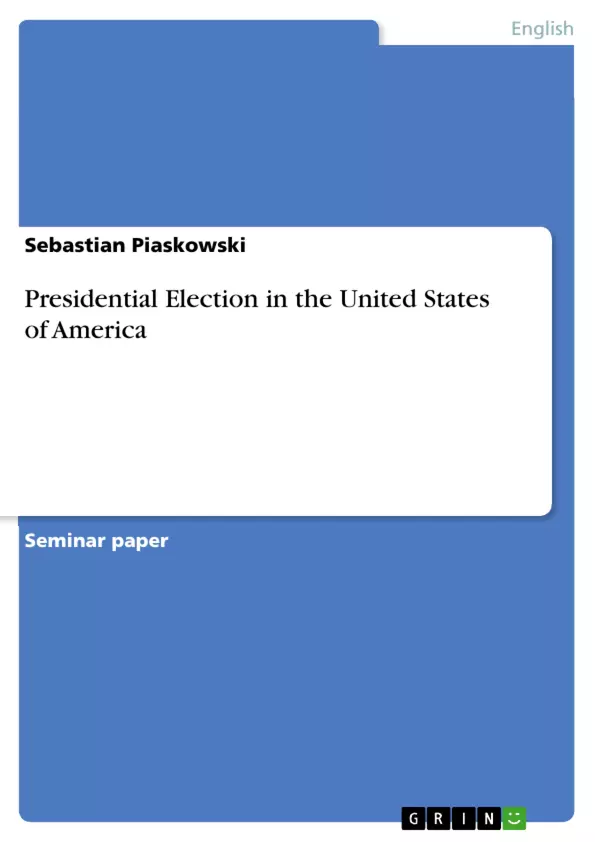This paper deals with several topics connected with the election President in the United States of America but concentrates on history and the method of electing from the pre-election to the General one. After this theoretical part the weak points of this system are to be analyzed by the election of 2000. The ending of the paper gives a short overview about alternative ideas and a shift that is to be expected in the election system combined with the author’s own opinion. The President has a wide range of executive power as it is written in the Constitution, Article II: "The executive power shall be vested in a President of the USA”. Such a powerful human being requires to be elected carefully and because of that the founding fathers in 1787 invented a special system for electing politicians, especially the President. "Carefully" means to vote in an intelligent way under consideration of all current circumstances to minimize the risk of electing the wrong man to govern America, the most powerful country on earth. In 1800 people were not able to gather all the necessary pieces of information that were required for such an intelligent vote. The postal infrastructure consisted of letters delivered by postmen using horses who needed several weeks to travel from one city to another. The candidates of course were not able to visit every town to introduce themselves. Additionally, wartime hardened the situation of postal delivery. In the beginning the founding fathers discussed about the mode of election and the length of the executive term as the most important points. After several months of discussing one idea was striking -the electoral college-. A mode of electing that allows state legislatures to choose electors equal in number to the states, representatives and senators combined. These electors than are able to vote for one of the two candidates. - The amount of the number of delegates and electors per state depends on the amount of delegates in the Congress (House of Representative plus the Senate (two Senators per State)). So every state has at least a representation of 3 delegates or electors. [...]
Inhaltsverzeichnis (Table of Contents)
- Presidential Election in the United States of America
- The Electoral College
- Pre-Election
- The Caucus-Convention-System
- Primaries
- General Election
- Analysis of the Election System
Zielsetzung und Themenschwerpunkte (Objectives and Key Themes)
This paper explores the intricacies of the presidential election process in the United States of America. It delves into the historical context and the method of electing the President, from the pre-election phase to the General Election. The paper then analyzes the weaknesses of the electoral system, particularly through the lens of the 2000 election. Finally, it offers a glimpse into alternative ideas and potential changes to the election system, incorporating the author's perspective.
- The evolution and functioning of the Electoral College
- Pre-election methods including caucuses, conventions, and primaries
- The General Election and its significance
- Critical analysis of the electoral system's shortcomings
- Exploration of potential reforms and future directions
Zusammenfassung der Kapitel (Chapter Summaries)
- Presidential Election in the United States of America: This chapter introduces the concept of presidential elections in the US and emphasizes the need for a carefully chosen President due to the vast executive power vested in the office. It highlights the importance of an informed electorate in selecting the right leader for the nation.
- The Electoral College: This chapter delves into the historical origins and workings of the Electoral College, the system designed by the Founding Fathers to elect the President. It explains the role of electors, state representation, and the process of choosing the President and Vice President. The chapter emphasizes the system's enduring presence over two centuries.
- Pre-Election: This chapter explores the two main pre-election systems: the caucus-convention system and the primaries. It describes the inner workings of each system, including their multistage processes and the role of delegates. The chapter also examines the differences between the two systems and their impact on party representation.
Schlüsselwörter (Keywords)
The key concepts and themes explored in this paper include the US presidential election, the Electoral College, pre-election systems (caucus-convention and primaries), the General Election, electoral system analysis, and potential reforms. It delves into the historical context of the election system, its present workings, and potential future modifications.
- Citation du texte
- Sebastian Piaskowski (Auteur), 2005, Presidential Election in the United States of America, Munich, GRIN Verlag, https://www.grin.com/document/67488



